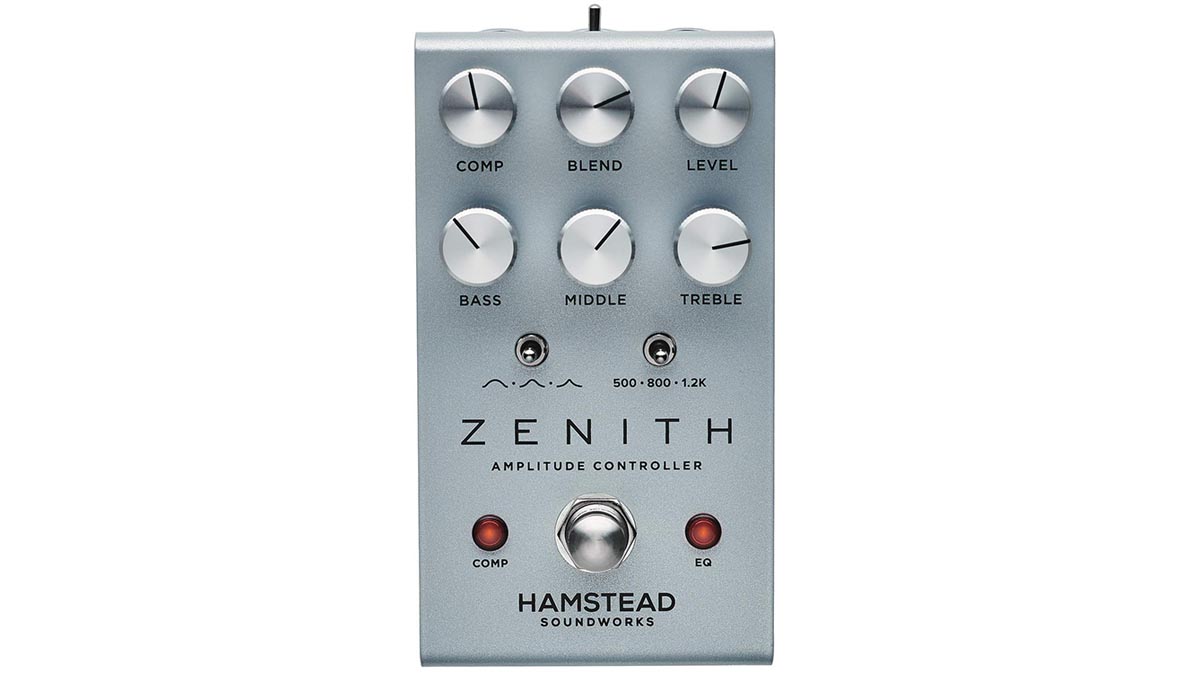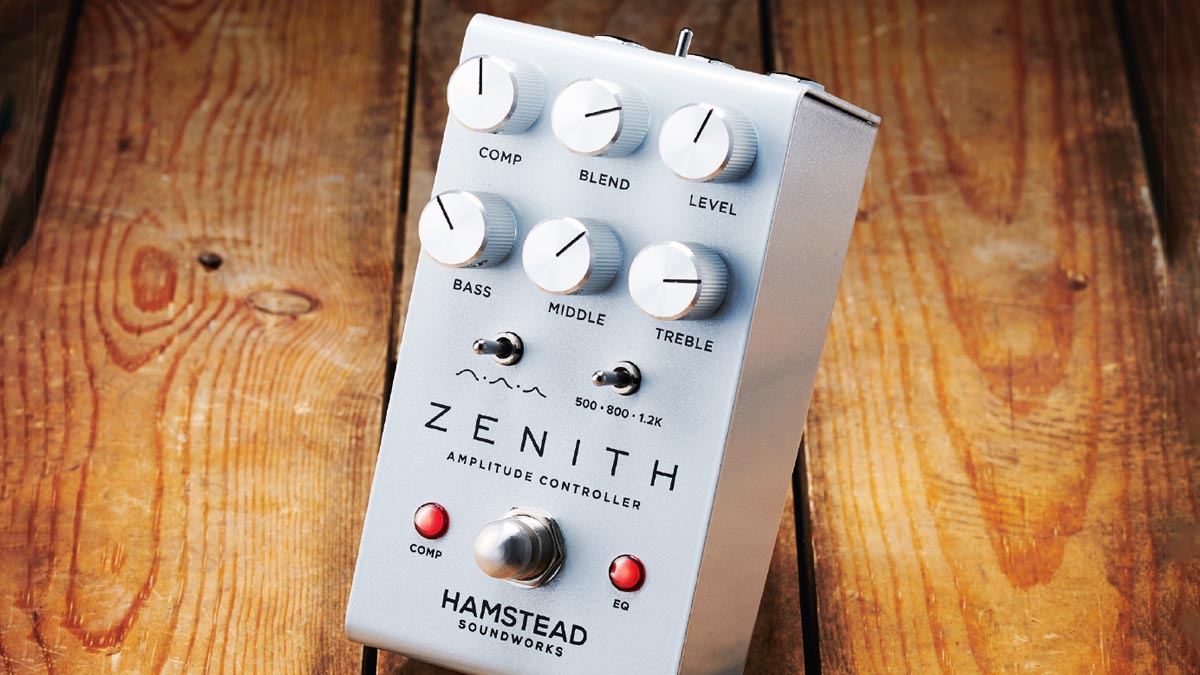Guitar World Verdict
Fully versatile as an always-on tonal building block, a switched-in variation, or a combination of both (in comp-only or EQ-only mode), the Zenith could be the perfect complement to your guitar and amp, offering practical options to enhance your core sound.
Pros
- +
Solid build quality.
- +
Compact size.
- +
Natural-sounding EQ with midrange options.
- +
Smooth compression.
- +
Substantial boost.
- +
OptoKick footswitch.
Cons
- -
Nothing.
You can trust Guitar World
Hamstead knows a thing or two about creating tone and its new pedal, the Zenith Amplitude Controller, is all about getting the best tone out of your own equipment by offering EQ, boost and compression in one place.
The signal path is all analogue, but three selectable routing options and some clever digital switching technology give you plenty of options for using the EQ and compression separately or combined.
Sounds
The three EQ knobs each offer 15dB of cut or boost with some selectable options on how the Middle operates: you can have centre frequencies of 500Hz, 800Hz or 1.2 kHz, and wide, medium and narrow Q (bandwidth).
This is quality musical tone-tweaking with the Bass knob rolling off unwanted weight or adding girth without sounding flabby, the Treble knob adjusting the natural airy top-end, and the Middle knob offering targeted tweaks such as a Tube Screamer-ish mid hump or a Fender black-panel-style mid scoop. The output Level knob can add up to 20dB of boost to solidly hit your amp’s front-end.
If your guitar hits the compressor first it will react to the full frequency of your playing dynamics, but putting the EQ first lets the compressor react to the EQ’d sound
Compression is controlled by a single knob and has a very fast attack and medium/long release. The very natural, smooth compression will even things out and add sustain with a pleasing note bloom at higher settings.
While it can affect note attack (although not the more extreme envelope change at the start of a note like, say, a Dynacomp), you can put some of that back by rolling the Blend knob back from 100 per cent wet and bringing in a proportion of your dry sound.
You can choose to set the serial order of EQ and compression or run them in parallel. If your guitar hits the compressor first it will react to the full frequency of your playing dynamics, but putting the EQ first lets the compressor react to the EQ’d sound. This gives you the opportunity to tailor its operation, so you can set it not to overreact to low-end frequencies, for example.
In Parallel mode the signal is split, so both get it equally, giving you the chance to mix two different versions of your original tone – one compressed and one with a different EQ profile layered together to create a composite sound.
Hamstead has built what it calls ‘secret switching’ into the pedal. As standard, the Zenith operates like any pedal with the footswitch bypassing the whole effects (EQ and comp).
However, you can hold the footswitch down for a couple of seconds and then use it to scroll through all the modes. Flip/Flop mode uses the footswitch to alternate between EQ and comp, which is useful if you’re using the pedal with a separate switcher for bypass – the pedal’s footswitch then becomes the effect selector.
There’s EQ Always On and the previously mentioned Comp Always On modes, with the footswitch bringing in the other effect. This is great if you want one of the effects as an always-on tonal component and then to bring the other in when needed.

We liked this when running the effects in parallel, keeping a touch of compression permanently on and switching an EQ-enhanced boost in when needed. In Comp Always On mode the Level knob is inactive until the EQ is switched in, so you can set it where you want for the amount of extra kick needed.
Finally, there’s Cycle where subsequent presses go from bypass to comp on to EQ on to both on. Independent switching of the EQ and comp circuits is also possible via external footswitch.
It’s one of those pedals that just gives you more: playing through it with some mild compression, a little treble lift and a few decibels of boost delivers a real enhanced quality that is immediately missed when bypassed.
But that’s just one of a range of practical functions it is capable of in front of a decent amp. It can also be put to use in an amp’s effects loop where, with careful adjustment, you can use it to attenuate volume to keep levels low while still retaining the sound and feel of your cooking amp.
Verdict
Fully versatile as an always-on tonal building block, a switched-in variation, or a combination of both (in comp-only or EQ-only mode), the Zenith could be the perfect complement to your guitar and amp, offering practical options to enhance your core sound.
Specs
- PRICE: $349 / £289
- ORIGIN: UK
- TYPE: Boost, EQ and compressor pedal
- FEATURES: Buffered bypass, OptoKick footswitch
- CONTROLS: Comp, Blend, Level, Bass, Middle, Treble, Q switch, Frequency switch, Circuit Order switch, internal trim pot for Compressor Master Level, bypass footswitch
- CONNECTIONS: Standard input, standard output, standard Control input
- POWER: 9V / 18V DC adaptor (not supplied) 280mA at 9V
- DIMENSIONS: 70 (w) x 130 (d) x 65mm (h)
- CONTACT: Hamstead Soundworks
- More of the best EQ pedals
Trevor Curwen has played guitar for several decades – he's also mimed it on the UK's Top of the Pops. Much of his working life, though, has been spent behind the mixing desk, during which time he has built up a solid collection of the guitars, amps and pedals needed to cover just about any studio session. He writes pedal reviews for Guitarist and has contributed to Total Guitar, MusicRadar and Future Music among others.
“The original Jordan Boss Tone was probably used by four out of five garage bands in the late ’60s”: Unpacking the gnarly magic of the Jordan Boss Tone – an actual guitar plug-in that delivers Dan Auerbach-approved fuzz
“This is a powerhouse of a stompbox that manages to keep things simple while offering endless inspiration”: Strymon EC-1 Single Head dTape Echo pedal review












